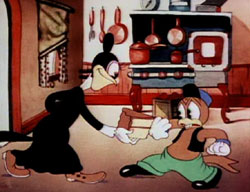 The Technicolor "Loony Tunes" animated short I Only Have Eyes For You (1937) plays with a song from the Busby Berkley musical comedy Dames (1934), though only the song directly relates to the movie & there are no spoofs of the film's story content.
The Technicolor "Loony Tunes" animated short I Only Have Eyes For You (1937) plays with a song from the Busby Berkley musical comedy Dames (1934), though only the song directly relates to the movie & there are no spoofs of the film's story content.
It begins with the ice-deliveryman (a bird with an ice truck) bringing ice from door to door to carry in houses & deposit in ice boxes.
His first delivery is to a homely spinster turkey. The soundtrack features a boogie-woogie song about the deliveryman hating to bring ice to this address because of the aggressive old maid is always putting the moves on him.
Further down the road, however, is Katie Canary, a sweet lookin' chick. The bucktooth stuttering golly-shucks hick of a deliveryman prefers this babe to the old maid turkey, as though he were any prize.
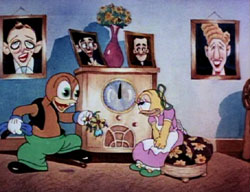 Katie quite rightly finds him unappealilng. Sp she likes only crooners on the radio. She tells him, in her Katherine Hepburn voice, "Please go away." Katie quite rightly finds him unappealilng. Sp she likes only crooners on the radio. She tells him, in her Katherine Hepburn voice, "Please go away."
Due to his speech impediment (the ice man is voiced by Joe Dougherty who also created the stuttering voice of Porky Pig, later emulated by Mel Blanc), he can't seduce Katie with a song, though nothing less will do. So he hires a ventroloquist, Professor Mockingbird, to make it sound like he can sing "I Only Have Eyes for You."
Under these false expectations, Katie Canary falls for the deliveryman. But the mockingbird in the back of the ice truck is freezing & makes the vulture-necked deliveryman start singing like a teeth-chattering old man with a bad cold. Katie sees through the ruse, :& runs off with the mockingbird.
Our deliveryman decides to settle for the ugly turkey woman since at least she can cook. Overall, a pretty good cartoon, through horrifically sexist.
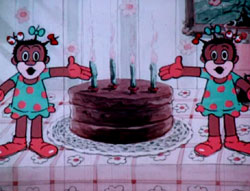 A Technicolor Merrie Melodies cartoon, Those Beautiful Dames (1934) was a tie-in for the Busby Berkeley musical Dames, built around the Warren & Dubin tune. A Technicolor Merrie Melodies cartoon, Those Beautiful Dames (1934) was a tie-in for the Busby Berkeley musical Dames, built around the Warren & Dubin tune.
It begins with a Little Match Girl type of scenario, an impoverished red-haired little girl in rags, freezing her way home in a storm. She stops momentarily at the window of a toyshop, admiring all she sees, then tramping along her way in misery.
At home even the mice are starving. She tries to build a fire in the potbellied stove, but melting ice puts out her best effort at a flame. Falling asleep, she doesn't see all the dolls & toys that followed her home from the toyshop.
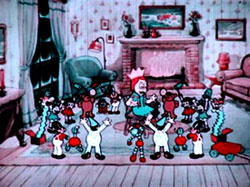 They work through the night gussying up the joint. When she wakes at dawn, she magically lives in a beautiful big home with a roaring fire in a fireplace. And the dolls sing & dance & put on a fine show for her. They work through the night gussying up the joint. When she wakes at dawn, she magically lives in a beautiful big home with a roaring fire in a fireplace. And the dolls sing & dance & put on a fine show for her.
Apart from the inevitably racist caricatures that spoil cartoons of this era (the black-face pickaninnie dolls with the chocolate cake for instance), Those Beautiful Dames is really very sweet. The antics of the talented & helpful toys is delightful.
The toys serve the formerly ragged little girl deserts at the feast of unhealthy treats. And even though she's still apparently an orphan, & this seems likely to be all a dream, in fact the fantasy is sustained to the end. She does not turn out to be dead & in a dreamlike heaven like the Little Match Girl, but has really been brought into the magical world of toys sprung to life.
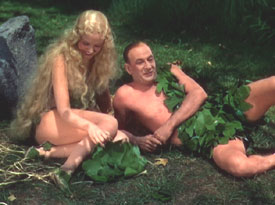 The above pair of cartoons were included on the Dames disc in the Warner Home Video six-dvd set The Busby Berkley Collection (2006).
The above pair of cartoons were included on the Dames disc in the Warner Home Video six-dvd set The Busby Berkley Collection (2006).
Also among the extras was the two-reel short subject Good Morning, Eve! (1934) which does not relate at all to Dames or Busby Berkley, but is fun to have even if it is all pretty damned lame.
It has the historical distinction of being the second three-strip Technicolor film ever made with live actors, & the first Technicolor film shot outdoors. The color has reached our generation still sharp & good. There is also a black & white version in circulation, though truth be told, well over half its appeal is in the color process.
In Eden, Adam (comic Leon Errol) is sleeping late in the grass. Eve (Ziegfield's busty showgirl June McCloy) is up sewing fig leaves together. Adam wakes & they do some punning shtick.A snaky puppet Eve to prepare Adam a feast of the forbidden apple.
They then walk down a dirt road of history. They arrive in Rome in time for a big show put on for Nero (Vernon Dent). Nero sings a song about his fiddle, nice & jumping.
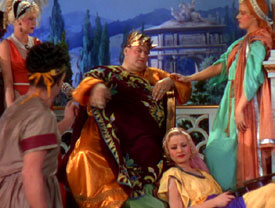 Chorus girls sing & a hillbilly band called the Fiddler's Quartet reprises Nero's song. The hillbilly quartet is headed by fiddler Eddie Foster who around this time performed with the Georgia Washboard Stompers. He played minor character roles in many films of the '30s & '40s. Chorus girls sing & a hillbilly band called the Fiddler's Quartet reprises Nero's song. The hillbilly quartet is headed by fiddler Eddie Foster who around this time performed with the Georgia Washboard Stompers. He played minor character roles in many films of the '30s & '40s.
Nero's gals also appear in chorus lines of a number of Busby Berkley musicals but are never credited, but one of them is Martha Merrill, who stars in And She Learned About Dames (1934).
The Nero number & two more songs to be heard are Cliff Hess compositions. Hess was a kind of "poor man's Warren & Dubin" who hacked 'em out for Warner Vitaphone shorts.
Adam & Eve take off down the road anew, arriving in medieval England. They meet Sir Lancelot (Bill Elliott, who later starred in a long running series of B westerns) & his foe the Black Knight. Adam helps Lancelot win out over his foe.
There are some goofy tourney events for Arthur & Guenevere's entertainment. The Genevere sings "In King Arthur'ws Reign," a bad song badly sung. The chorus girls have longbows & arrows as they dance calesthetics style, & men in armor do a mock ballet skipping in a circle.
Further down the dusty road Adam & Eve find themselves in the jazz age. An airplane lands & they climb aboard. Off they go to the beach.
A horndog (Harry Seymour) on the beach sings a crummy novelty tune about "Lookin' at Babies" while beach babes do drill team calistehtetics which serve as this film's notion of dancnig. Adam gets assaulted by a police officer & then Adam & Eve wake up from a dream. They were all along in a nudist colony.
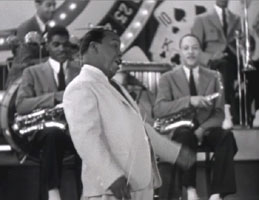 By far the best extra of the lot is genuine treasure, Melody Master: Don Redman & His Orchestra (1934). Bandleader Don Redman has just opened the Take-a-Chance Club. It's the hottest new cabaret in town, funded with his sweepstakes winnings.
By far the best extra of the lot is genuine treasure, Melody Master: Don Redman & His Orchestra (1934). Bandleader Don Redman has just opened the Take-a-Chance Club. It's the hottest new cabaret in town, funded with his sweepstakes winnings.
Don's orchestra is jamming in front of a backdrop of giant cards & giant roulette wheel, establishing strongly that this is a gambling environment. The clientelle are seated at tables & chairs designed to look like giant dice.
There's some call & response happening between band members inclusive of a vocal rift by Don. A trumpet solo begins, & we're being treated to some spectacular jazz! The number is "Yeah, Man" written by J. Russell Robinson & Nobel Sissle.
The second number, "Ill Wind" written by Harold Arlen & Ted Koehler, is very bluesy. The scene cuts to a film within the film, about a man who loses his girl, as lyrics on the soundtrack tell the tale:
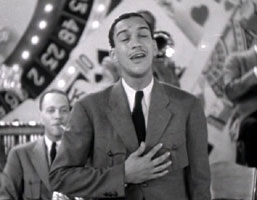 "Ohhh, ill winds blow me away/ Let me rest today/ You're blowing me no good, no good...." We get two enacted vignettes, though by the end we find that an ill wind can blow some good. "Ohhh, ill winds blow me away/ Let me rest today/ You're blowing me no good, no good...." We get two enacted vignettes, though by the end we find that an ill wind can blow some good.
This is a superfine number done complete justice by the usual crooner for Don's band up to 1936. He's Harlan Lattimore, who was sometimes billed as "the Black Crosby."
Before he was with Don's orchestra, he had his own band, Harlan Lattimore & His Connie's Inn Orchestra. This was the house band for a Harlem cabaret which catered primarily to a white clientelle eager to see black entertainers, a more intimate version of the Cotton Club.
"The tree of hope" sprang from the concrete walkway beside Connie's Inn, & until it was cut down in 1934, entertainers would visit the stump for good luck, including Fletcher Henderson, Eubie Blake, Ethel Waters, Bill Bojangles Robinson, & other Connie's Inn regulars. Today the last remnant of that legendary stump sits on the Apollo Theater Stage.
Harlan was headed for stardom but became increasingly unpredictable -- whether from mental illness, or drug abuse as rumored, too little is recorded about his life to be certain -- so that Don was forced to let him go. After that, his career went into slow fade & eventual obscurity.
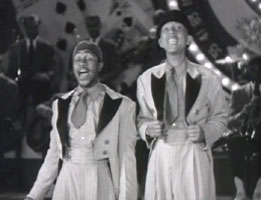 A third number backs up a couple of guys on the Fujiyama Mamma song wherein the women Wicky Wacky Woo, i.e., "Nagasaki" written by Harry Warren & Mort Dixon in 1928. A third number backs up a couple of guys on the Fujiyama Mamma song wherein the women Wicky Wacky Woo, i.e., "Nagasaki" written by Harry Warren & Mort Dixon in 1928.
These two guys are great talents but the song is intentional camp, so they corn it up with lots of nonsense lyrics before leaping into their dance routine.
These guys were billed as "Red & Struggie." They are the floppy shoes baggy pants clown style of vaudeville commedians. "Clowns" underestimates the best of the type, for as Red & Struggie prove, you gotta be a great singer & fine tapdancer as well as funnier'n hell.
This short subject is just about the only chance to see these guys, though that might be Red & Struggie guest-dancing in the Cab Calloway sequence for "Mamma, I Wanna Make Rhythm" in Manhattan Merry-Go-Round (1937). The fuller identities of these two chaps is uncertain, but the taller guy, Struggie, has been tentatively identified as scat artist Leo Watson.
Don sits down on a dice-table & flirts with a girl (that gal is Butterfly McQueen of Gone with the Wind fame). Some jealous guy calls him "Shorty" so he stands up & does a rap number about being a high-strutting short guy who girls adore. The number "Why Should I Be Tall?" & it is very funny.
copyright © by Paghat the Ratgirl
|
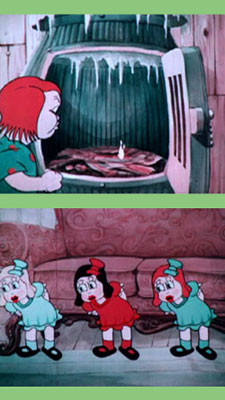

 Katie quite rightly finds him unappealilng. Sp she likes only crooners on the radio. She tells him, in her Katherine Hepburn voice, "Please go away."
Katie quite rightly finds him unappealilng. Sp she likes only crooners on the radio. She tells him, in her Katherine Hepburn voice, "Please go away."
 They work through the night gussying up the joint. When she wakes at dawn, she magically lives in a beautiful big home with a roaring fire in a fireplace. And the dolls sing & dance & put on a fine show for her.
They work through the night gussying up the joint. When she wakes at dawn, she magically lives in a beautiful big home with a roaring fire in a fireplace. And the dolls sing & dance & put on a fine show for her.
 Chorus girls sing & a hillbilly band called the Fiddler's Quartet reprises Nero's song. The hillbilly quartet is headed by fiddler Eddie Foster who around this time performed with the Georgia Washboard Stompers. He played minor character roles in many films of the '30s & '40s.
Chorus girls sing & a hillbilly band called the Fiddler's Quartet reprises Nero's song. The hillbilly quartet is headed by fiddler Eddie Foster who around this time performed with the Georgia Washboard Stompers. He played minor character roles in many films of the '30s & '40s.
 "Ohhh, ill winds blow me away/ Let me rest today/ You're blowing me no good, no good...." We get two enacted vignettes, though by the end we find that an ill wind can blow some good.
"Ohhh, ill winds blow me away/ Let me rest today/ You're blowing me no good, no good...." We get two enacted vignettes, though by the end we find that an ill wind can blow some good. A third number backs up a couple of guys on the Fujiyama Mamma song wherein the women Wicky Wacky Woo, i.e., "Nagasaki" written by Harry Warren & Mort Dixon in 1928.
A third number backs up a couple of guys on the Fujiyama Mamma song wherein the women Wicky Wacky Woo, i.e., "Nagasaki" written by Harry Warren & Mort Dixon in 1928.